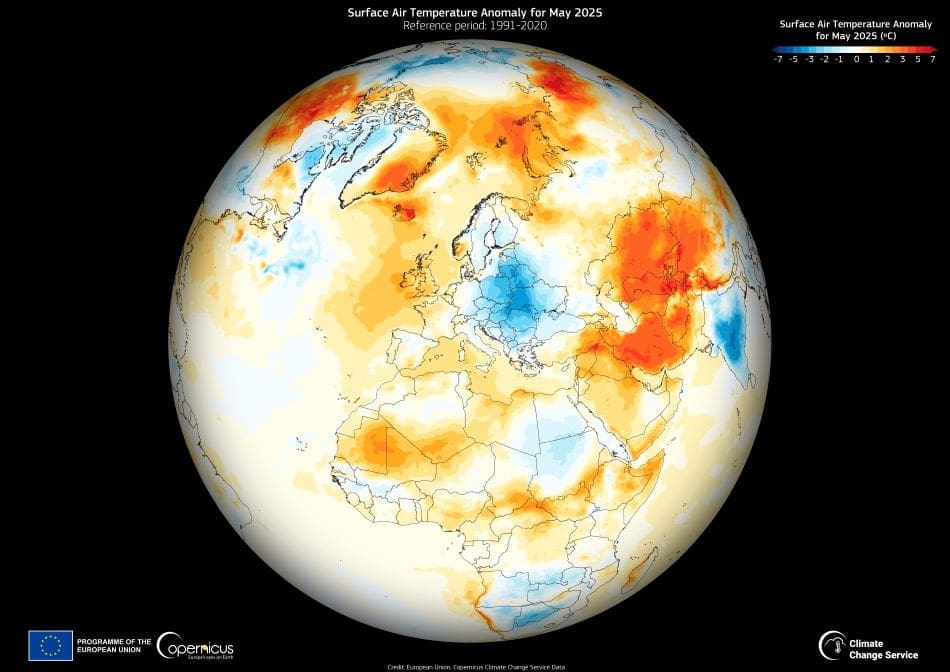May 2025 was the second warmest May ever recorded globally, with an average surface air temperature of 15.79°C – 0.53°C above the 1991–2020 average – according to the Copernicus Climate Change Service (C3S). It was also just the second month in the past 23 that did not exceed 1.5°C above pre-industrial levels, a benchmark set by the Paris Agreement to limit long-term global warming.
Fourteen of the last 23 months – spanning September 2023 to April 2024 and October 2024 to March 2025 – were well above 1.5°C, with values ranging from 1.58°C to 1.78°C. Several other months, including May 2025, came very close to the threshold, registering between 1.50°C and 1.54°C. While ERA5 data provides the reference for these figures, small differences across datasets and estimates of historical baselines introduce some uncertainty in comparing these values precisely.

This Copernicus Sentinel image depicts surface air temperature anomalies for May 2025 in the Northern Hemisphere. Areas shaded in red experienced above-average temperatures, while blue shows cooler-than-average conditions. The data reveal a marked east-west divide across Europe: Eastern Europe, from the Balkans to Finland, was mostly colder than normal, with the strongest cold anomaly centred over and near western Ukraine. Bulgaria recorded one of its three coldest Mays since 2005. By contrast, Western Europe experienced warmer conditions. Iceland set a new national May record of 26.6°C during a mid-month heatwave, and the United Kingdom recorded its fifth-warmest May.
Beyond Europe, temperature extremes were widespread. Above-average temperatures dominated parts of western Antarctica, northeastern Russia, northern China, and northern Canada. Intense heatwaves affected Iran and Pakistan. Meanwhile, India experienced the month’s most pronounced cold anomaly, linked to unusually wet conditions. Alaska, southern Africa, and eastern Antarctica also saw colder-than-average weather. In Australia, southeastern regions were warmer, while the northwest remained cooler than normal.
In the oceans, a marine heatwave developed in the northeastern North Atlantic in May. On 23 May, sea surface temperatures (SST) off Ireland reached more than 4°C above the 1991–2020 average. The broader region registered a daily anomaly of 1.75°C – the highest value recorded outside of 2023. This event followed months of record-setting SSTs for the time of year, driven by persistent anticyclonic conditions that brought clear skies, high solar radiation, and light winds. The same conditions contributed to the United Kingdom’s sunniest spring since national records began in 1884.
The global average sea surface temperature for May 2025 was 20.79°C, making it the second highest on record for the month – 0.38°C above the 1991–2020 average. While this was 0.14°C lower than in May 2024, it remained 0.02°C higher than the May 2023 value, continuing the trend of exceptionally warm ocean conditions since March 2023.
Article Source:
Press Release/Material by Copernicus Climate Change Service (C3S)
Featured image credit: European Union, Copernicus Climate Change Service Data



